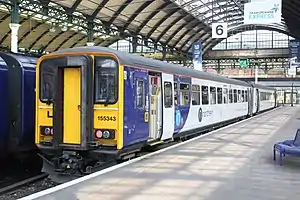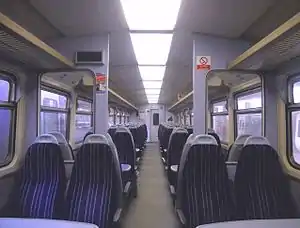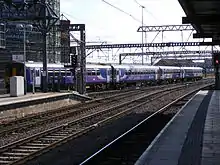British Rail Class 155
The British Rail Class 155 is a diesel multiple unit. These DMUs were built by Leyland Bus at Workington (incorporating some Leyland National bus components) between 1987 and 1988 as part of British Rail's replacement of its ageing first-generation diesel fleet. 42 units were originally built, however only 7 remain; the other 35 units were converted to Class 153 railcars.
| British Rail Class 155 Super Sprinter | |
|---|---|
 Northern 155343 at Hull Paragon in August 2019 | |
 The unrefurbished interior of a Northern Rail Class 155 DMU | |
| In service | 1987 - present |
| Manufacturer | Leyland Bus |
| Order no. |
|
| Built at | Leyland Bus, Workington[2] |
| Family name | Sprinter |
| Replaced | First generation DMUs |
| Constructed | 1987 - 1988 |
| Entered service | 1988[2] |
| Refurbished | 2006 - 2007 |
| Number built | 42 trainsets |
| Number in service | 7 trainsets |
| Formation |
|
| Diagram | |
| Fleet numbers |
|
| Capacity | |
| Operator(s) | |
| Depot(s) | Neville Hill[1] |
| Line(s) served | |
| Specifications | |
| Car body construction | Steel[4] underframe. Powder coated steel body and roof with some aluminium non-structural panels. |
| Car length | 23.208 m (76 ft 1 3⁄4 in)[3] |
| Width | 2.700 m (8 ft 10 1⁄4 in)[3] |
| Height | 3.746 m (12 ft 3 1⁄2 in)[3] |
| Doors | Single leaf sliding plug[4] |
| Articulated sections | 2 |
| Wheelbase |
|
| Maximum speed | 75 miles per hour (121 km/h)[1] |
| Weight |
|
| Prime mover(s) | one per car, Cummins NT855R5[4][1] |
| Engine type | 14-litre turbo-Diesel |
| Cylinder count | 6 |
| Power output | 285 hp (213 kW) |
| Transmission |
|
| Train heating | Warm air, hot water radiators[3] |
| Bogies | |
| Braking system(s) | Air/EP[4] |
| Safety system(s) | |
| Coupling system | BSI[6] |
| Multiple working | Classes 14x, 15x, 17x[4] |
| Headlight type | Fluorescent[3] |
| Track gauge | 1,435 mm (4 ft 8 1⁄2 in) standard gauge |
| Notes | |
| All cars in sets 155301-155335 converted to Class 153 | |
Background
By the beginning of the 1980s, British Rail (BR) operated a large fleet of first generation DMUs, which had been constructed in prior decades to various designs.[7] While formulating its long term strategy for this sector of its operations, British Rail planners recognised that there would be considerable costs incurred by undertaking refurbishment programmes necessary for the continued use of these aging multiple units, particularly due to the necessity of handling and removing hazardous materials such as asbestos. In light of the high costs involved in retention, planners examined the prospects for the development and introduction of a new generation of DMUs to succeed the first generation.[8]
In the concept stage, two separate approaches were devised, one involving a so-called railbus that prioritised the minimisation of both initial (procurement) and ongoing (maintenance & operational) costs, while the second was a more substantial DMU that could deliver superior performance to the existing fleet, particularly when it came to long distance services.[8] The initial specification developed for the latter concept was relatively ambitious, calling for a maximum speed of 90 MPH (145 km/h), acceleration comparable to contemporary EMUs, the ability to couple/work in multiple with existing EMUs, facilitate through-access for passengers, feature pressure ventilation, the ability to assist a failed unit, and to comprise either a three or four-car consist.[8] This specification led to the experimental British Rail Class 210 DMU. However, it was found that relatively expensive equipment was needed for the performance specified, particularly to provide sufficient speed, acceleration, and through-passenger access; maintainability also suffered due to space limitations. It was recognised that a production model assembled from proven components would possess greater reliability and lower maintenance costs; an availability rate of 85 percent was forecast.[8]
By 1983, experiences with the Class 210 had influenced BR planners to favour procuring a new generation of DMUs, but to also adopt a new specification that were somewhat less demanding than before.[8] Specifically, it was decided to drop the top speed from 90 MPH to 75 MPH, as testing had revealed the higher rate to deliver no perceivable improvement in journey times due to the typically short spacing of the stations the type was intended to serve. Furthermore, it was determined that a propulsion system delivering 7 hp per tonne would deliver sufficient acceleration.[8] The requests for compatibility with other rolling stock were eliminated, although auto-coupling and auto-connecting functionality was added. In addition to a good ride quality, the specification included a sound level of 90 dB when at full speed, an operational range of 1,000 miles, and an interval between major overhauls of five years or 350,000 miles.[8] While the prior generation of DMUs typically used a pair of engines for each power car, the specification called for only a single engine per car, as well as for sufficient cooling so that, even with one failed engine, a two-car unit could maintain a typical service performance without major deficient.[8] It was also intended that the DMU could be assembled akin to building blocks, comprising between two and four cars that could be outfitted with various passenger amenities such as toilets and luggage spaces.[8]
Initially formalised as a business specification, these requirements were transferred into a relatively broad technical specification that avoided any specifics other than those that were deemed essential for compatibility purposes. Thereafter, it was issued to various rolling stock manufacturers for an competitive tender.[8] Under this process, responding manufacturers submitted bids to construct an initial series of three-car demonstration units. A constrained timetable of only 18 months between the date of order to delivery of these prototypes was also specified; this has been attributed as having compelled manufacturers to lean towards existing industrial practices for their submissions.[8] The bid submitted by British Rail Engineering Limited (BREL) was heavily based on its successful Class 455 EMU, sharing its body and the majority of its running gear, albeit equipped with two different power trains. The railway engineering company Metro-Cammell also bid, offered its own design that employed rivetted aluminium construction; this approach produced a meaningful weight reduction over conventional methods.[8] BR officials opted to proceed with a pair of prototypes from both BREL and Metro-Cammell, resulting in the Class 150 and Class 151 respectively.[8]
Between 1984 and 1985, these prototype units were delivered to BR and commenced their trial service period.[9][10] Both the Class 150 and 151 units were subject to extensive evaluations with the aim of a larger production order being forthcoming for the more successful of the two types. Testing revealed that the Class 150 had exception ride quality, as well as fully satisfying the 50 percent engine-out performance requirements.[8] It was also determined that both types achieved adequate noise levels for its intended service sector, but were also noted that this area would likely pose an issue if they were ever directed towards the higher end of the market. Early concerns regarding the body bending frequency of the Class 151 did not prove to have major substance to them.[8] Ultimately, the Class 150 prototypes proved to be more reliable and an order for 50 two-car units was accordingly issued to BREL, leading to a production batch of Class 150s.[8]
Even prior to the introduction of the Class 150, there was a recognised interest within BR at potentially tasking the new DMU with the replacement of other services, targeting not only first-generation DMUs but a number of locomotive-hauled trains as well.[8] It had also been observed that, in its current configuration, the Class 150 would be unsatisfactory in some criteria for more-upmarket services, but that some thought into developing derivatives of the type to handle such services had been made. One early solution for reducing internal noise levels was the discarding of openable windows in favour of fully-sealed units, along with the relocation of the external doors into vestibules located at either ends of each coach.[8] Furthermore, the coaches could be stretched, providing more internal volume and thus enabling the somewhat cramped two-by-three seating arrangement of the Class 150 to be substituted with a more roomy two-by-two counterpart. These changes could be implemented without impacting much of the benefits of adopting the existing design.[8] It was identified that this would result in a weight increase and thus a decreased power-to-weight ratio.[8]
Studies determined that the performance of the proposed DMU showed only minor change, and would achieve similar journey times across the intended cross-country routes to the Class 150.[8] It was also found that, while there was a slight increase in fuel consumption due to the modifications, the envisioned DMU possessed significantly less fuel consumption than locomotive-hauled trains as well as reduced maintenance costs. Accordingly, it was decided to proceed with developing a detailed specification and issuing it to industry.[8] Amongst the requirements listed in the issued specification was the explicit statement of the acceptability of the proven power trains of both the Class 150 and Class 151 for this requirement.[8]
Description


The Class 155 consists of a pair of coaches, each possessing a length of 23 metres, a considerable stretch over their Class 150 predecessor.[8] Both coaches are powered, each being furnished with a single underfloor-mounted Cummins NT855R5 engine, which was capable of generating up to 285 hp, that delivered power to the wheels via a Voith-built hydraulic transmission.[11][12]
The fleet was part of the "Super Sprinter" build, the other part of which was the Class 156 fleet - though only the latter carried the "Super Sprinter" branding. They were manufactured by British Leyland, who used similar construction techniques to those used on the more basic Pacer railbuses. The relatively lightweight body, which was mounted on a welded floor assembly, comprised a series of pre-formed panels that were fixed together via the extensive use of Avdel rivets. The body is lined with a somewhat large number of windows, which is said to make the coaches appear unusually long; despite considerations towards adopting sealed windows to reduce noise levels, the windows are openable for natural ventilation.[8] It has been observed that, as a byproduct of the vehicle's lightweight construction and length, certain coaches have exhibited a slight, but visible, sag.
Operations
The Class 155 was introduced to service at a rapid rate, despite the presence of some teething issues with the type. The units were the first BR DMUs to be furnished with sliding-plug automatic doors which closed to provide a smooth bodyside rather than sliding back into the bodyshell (the system used with 150s and 151s). During their early service, it was found that these doors often failed to work properly; there were reports of the doors opening while the trains were in motion.[13] Consequently, the fleet was temporarily taken out of use and modified, while the 156s were assigned to perform their diagrams as an interim measure.[14]
Following this modification work, the performance of the Class 155 improved substantially. An emerging requirement for replacement rural lines stock ultimately led to the decision to convert the majority of the Regional Railways' Class 155 fleet into a single car configuration, enabling these units to replace the elderly 121 and 122 "Bubblecar" units. Originally, it had been intended for these single-car units, which had been introduced roughly 30 years prior, to be withdrawn and entirely replacement by the incoming Pacer fleet; however, experience with the Pacers determined that they were unable to work the sharply-curving steeply-graded branchlines involved. Instead, the Pacers were moved to replace a number of Class 150s, the 150s took over certain 156 diagrams, and the 156s took on the 155 services which were not handed over to the new Class 158s. The 155s emerged from the workshops as single car Class 153s, and were put to work augmenting two car units and on the quiet Cornish, Welsh, North-Western, Norfolk and Lincolnshire branch lines. They do not operate North of the Scottish border. However, West Yorkshire Passenger Transport Executive refused to allow the seven units which they owned to be converted, and these were merely modified to operate reliably in original form. The conversion to single car units was notable for not requiring any external doors to be moved, although this has led to the No.2 cab being unusually cramped, despite being extended into the vestibule area.
The previously mentioned seven remaining Class 155 units, which are numbered 155341 to 155347, were constructed in 1988 for West Yorkshire Passenger Transport Executive (WYPTE) for their MetroTrain services, and have continued to serve in their original formation across multiple decades.[11] The type is currently operated solely by Northern Trains. They were previously frequently seen on Manchester Victoria to Leeds services but, as of 2019, the Class 155s are allocated to Hull and mostly operate routes in Yorkshire.
Fleet details
| Class | Operator | No. Built | Year Built | Cars per Set | Unit nos. | Formation |
|---|---|---|---|---|---|---|
| Class 155 | Northern Trains | 7 | 1987-1988 | 2 | 155341-155347 | DMSL-DMS |
| Converted to Class 153 | 35 | 155301-155335 |
Model railways
In 2000, Hornby Railways launched its first version of the BR Class 155 in OO gauge.[15]
References
Citations
- Fox & Hughes 1994, pp. 32–33
- Marsden 2011, p. 118
- Vehicle Diagram Book No. 220 for Diesel Multiple Unit Trains (Railcars) (PDF). Barrowmore MRG. Derby: British Railways Board. 1982. DP248, DP249.
- "Class 155". The Railway Centre. Archived from the original on 9 March 2005.
- "The Northern Interim Franchise Agreement" (PDF). Bevan Brittan LLP. 26 March 2014. p. 78. Retrieved 22 April 2015.
- "System Data for Mechanical and Electrical Coupling of Rail Vehicles". Rail Safety and Standards Board. Archived from the original on 5 July 2008. Retrieved 5 January 2009.
- St John Thomas, David; Whitehouse, Patrick (1990). BR in the Eighties. Newton Abbot: David & Charles. ISBN 0-7153-9854-7.
- Shore, A. G. L. (1987). "British Rail diesel multiple unit replacement programme". CiteSeerX 10.1.1.1008.3291. Cite journal requires
|journal=(help) - "Class 151 is Met-Cam's bid in DMU replacement battle." Railway Gazette International, May 1984. p. 364.
- "Market." Railway Gazette International, April 1985. p. 237.
- "The Class 150 Series of DMUs". 9 August 2013. Retrieved 12 June 2018.
- "Class 155 Super Sprinter DMU". www.traintesting.com. Retrieved 12 June 2018.
- "DMU Classes 153-159". www.angelfire.com. Retrieved 12 June 2018.
- "Class 155". Sprinters. Retrieved 12 June 2018.
- "Hornby BR Class 155 Sprinter". Hornby Railways Collector Guide. Retrieved 2 February 2020.
External links
| Wikimedia Commons has media related to British Rail Class 155. |